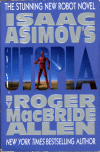Foundation by Isaac AsimovFoundation by Isaac Asimov
It is hard to write a review about one of the most famous science fiction novels of all time, but I will try to do it justice. Asimov originally started the Foundation saga as a series of short stories for Astounding Magazine back in the 1940s. For the novelisation Asimov added the section “The Psychohistorians” to precede the original 4 stories that were published in the magazine. For those reading along with me in chronological order, most of this first story is covered in Foundation and Chaos. (more…)









